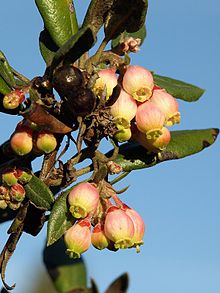- Xylococcus bicolor
-
Xylococcus bicolor 
Xylococcus bicolor in bloom with old fruit and leaves Scientific classification Kingdom: Plantae (unranked): Magnoliophyta (unranked): Magnoliopsida Order: Ericales Family: Ericaceae Genus: Xylococcus Species: X. bicolor Binomial name Xylococcus bicolor
Nutt.Xylococcus is a monotypic genus of flowering plants in the heath family which contains the single species Xylococcus bicolor, the Mission Manzanita. This is a shrub that grows to three meters in height, two meters in diameter. Its native range is very limited, comprising Southwestern and Pacific coastal California from San Diego county through north-central Pacific coastal Baja California, a bit of southern Riverside County near Temecula, and Santa Catalina Island. [1] It is a member of the chaparral plant community.
Contents
Description
The Mission Manzanita is a slow-growing shrub that resembles the true manzanitas (Arctostaphylos). The form is upright, usually with a single trunk and a roughly spheroid crown. Leaves are oblong, glossy dark green on the top and very light colored with a felty texture on the underside. The edges of the leaves curl under as they age. Bark is smooth and a red-gray color.
Flowers, which appear from December to February depending on rainfall, are white to pink in color blending to yellowish at the open end, 8-10mm in length and hang like bells in small clusters near the ends of branches.
Fruit is glossy dark red to almost black, 7mm diameter and has very little flesh, being mostly a large, woody seed. The name Xylococcus comes from the Greek for "wood berry".
- Mission Manzanita
Ecology
The Mission Manzanita is found mixed southern chaparral ecosystems below 3500' elevation on dry, sunny slopes in a very limited range of coastal areas of southern California and northern Baja California.
Birds, including the California Thrasher and Scrub jay, eat seeds. Hummingbirds, especially the resident Anna's Hummingbird, drink nectar from flowers. Various birds nest in Mission Manzanita and many use it for cover.
While some chaparral plant species require fire to germinate seeds and reproduce, Xylococcus bicolor does not, nor does it require openings left by wildfires. But as a chaparral member species it must have a means of coping with wildfire. It does so by resprouting from the base after its top has burned away. This mechanism works very well unless a second fire follows closely after the first. If the plant has not had time to sufficiently regenerate it will probably perish.[2]
- Ecology
Uses
The Luiseno Native American tribe bruised ripe berries and soaked them overnight in cold water to produce a cider-like drink. [3]
Cultivation
Requires full sun, well drained soil. Soil PH 6-7. USDA zones 7-10. Water regularly and mulch during first year. [4]
Coyote scat is a good source of fertile seed. At certain times of the year their scat is full of the seeds. Apparently the acid wash helps germination. [5]
Notes
- ^ Xylococcus bicolor, Calflora.org - a database of California native plants, http://www.calflora.org/cgi-bin/species_query.cgi?where-calrecnum=8369, retrieved 2009-01-21
- ^ Zedler, Paul H. (1982), Plant Demography and Chaparral Management in Southern California, Gen. Tech. Rep. PSW-58., Pacific Southwest Forest and Range Experiment Station, Forest Service, U.S. Department of Agriculture, pp. 124–126, and table 2, http://www.fs.fed.us/psw/publications/documents/psw_gtr058/psw_gtr058_2b_zedler.pdf, retrieved 2009-02-01
- ^ Wilson, Bert, Xylococcus bicolor, Las Pilitas Nursery, http://laspilitas.com/nature-of-california/plants/xylococcus-bicolor, retrieved 2009-01-21
- ^ Crouthamel, Steven J., Luiseño Ethnobotany, Palomar College, http://daphne.palomar.edu/scrout/luisenob.htm, retrieved 2009-01-21
- ^ DeHart, Jeanine (1994), Propagation Secrets for California Native Plants, California Native Plant Society, San Diego Chapter
References
- James Lightner San Diego County Native Plants, San Diego Flora (2004)
External links
- Jepson's "A Flora of California"
- Jepson Flora Project 1993 "Xylococcus bicolor"
- Photos of Xylococcus bicolor
See also
- Chaparral
- California chaparral and woodlands
- California coastal sage and chaparral ecoregion
- Xeriscape
Categories:- Ericaceae
- Flora of California chaparral and woodlands
- Flora of the Channel Islands of California
- Trees of California
- Trees of Baja California
- Trees of Mediterranean climate
- Garden plants of North America
- Ornamental trees
- Drought-tolerant trees
- Plants described in 1842
Wikimedia Foundation. 2010.






